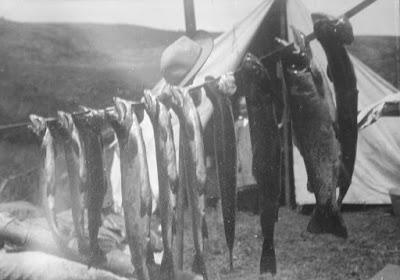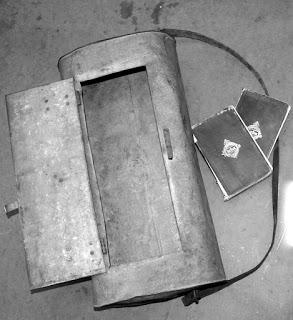
Student Leslie Goodding stands between Mrs. Nelson and her daughters. Stacks of felt sheets on the wagon and metal vascula on the ground attest to their mission in Yellowstone.
On June 13, 1899, two young men hopped off a freight train in Monida, Montana, then the western gateway of Yellowstone National Park. They were poor, but hardly drifters. Elias Nelson and Leslie Goodding were students from the University of Wyoming, accompanying a large load of freight shipped free of charge by the Union Pacific Railroad.They unloaded three horses, a state-of-the-art wagon with spring seats, a large canvas tent, ample bedding, a sheet iron wood stove, a large table with detachable legs, fishing gear, six plant presses, and thousands of sheets of white paper and felt. Two days later, their mentor arrived by passenger train—Professor Aven Nelson (no relation to Elias) with his wife Celia Alice and young daughters, ages 8 and 13. On June 17, the six departed for Yellowstone to collect plants. Fourteen weeks later, five returned.

Leslie Goodding drives, Mrs. Nelson and girls on seat behind—but where’s Elias?!
IMPROBABLE ADVENTUREYellowstone was designated the nation’s first national park in 1872, and by 1899, was a popular tourist destination—but only for the well-to-do. Commercial tours by stagecoach, generally the only way to visit, were too expensive for most people. Yet Professor Nelson (annual salary $1800) spent 14 weeks in the Park with his family and students, traveling and camping on their own, and collecting plants. Furthermore, they returned with 30,000 specimens—quite an accomplishment for an accidental botanist!Nelson had come to Laramie in 1887 to teach English at the brand new University of Wyoming (UW). But because the Trustees somehow hired two English professors, out of just six faculty total, Nelson agreed to teach biology (his schooling had included lectures on plants and a teaching assistantship in biology). Nelson’s focus soon narrowed to botany, launching a long and successful career.Like any respectable botany program, UW’s included an herbarium—a collection of dried plants which served as a resource for identification and study. But with just 1500 specimens, it was much too small for Nelson’s ambitions. He came up with a plan to greatly expand the herbarium and gain international recognition: he would collect plants in world-famous Yellowstone National Park!In early January, 1899, Nelson wrote to the Acting Superintendent of the Park and Captain of the 1st Cavalry (Yellowstone was overseen by the military at that time) requesting permission for an extended trip as a private party, to collect plants “to represent the vegetation of the Park in full.” Remarkably, an affirmative reply arrived just a few weeks later.Nelson’s plans were grand. He would collect not just single specimens of the various species, but also thousands of duplicates to sell or exchange with other collectors and institutions. However, this was far more than a single botanist could accomplish, even with his family’s assistance.HELP NEEDEDFortunately, Professor Nelson had a graduate student whom he greatly admired: Elias Nelson (“Elias” used here to avoid confusion with Professor Nelson). Elias was from Douglas, Wyoming, part of a family of Swedish immigrants. He entered as an undergraduate in 1894, and though he had to work to support himself, he finished in four years. In the fall of 1898, Elias became Professor Nelson’s first graduate student.
Professor Nelson also announced that he was seeking an undergraduate to serve as “chore boy” on the trip. Word of a chance to see Yellowstone quickly spread across campus. The lucky hire was Leslie Goodding, much to his surprise. Many juniors and seniors had applied, and Leslie was just a freshman—in fact, barely that. He would start at UW in the fall.
Goodding grew up in the tiny town of Granite, 30 miles east of Laramie, raised mainly by his grandparents. As he recounted many years later: “My country schooling left me handicapped … My speech was full of ain’ts, won’ts, has wents and the like. I was wholly lacking in courtesy and social polish.” Yet he attended Prep School, where UW professors taught college-bound students, and must have impressed his biology teacher, for Professor Nelson chose him for the Yellowstone job—at $10 per month and all expenses paid.WORK HARD, EAT WELL, SLEEP UNDER THE STARSThe Nelson expedition left Monida via the road east to Yellowstone. Four days out, the wagon became so badly mired in mud that it had to be unloaded before the horses could pull it free. After reaching the Park, they set up camp on the Madison River, intending to devote the next day to processing plant collections. But around midday, a soldier on patrol discovered them. He pressed lead plugs into their rifles, sealing them for the duration of their time in the Park, and directed Professor Nelson to go to Mammoth for his permit before doing any more collecting—a 46-mile, two-day detour.Once their paperwork was in order, they settled into a routine. Most days they broke camp early, and collected plants until late afternoon. Then they looked for a campsite. They were free to camp almost anywhere, choosing sites with firewood, water, grass for the horses, and a flat spot for the tent. Though the tent was large enough for six, “the boys” usually slept outside, “under the vaulted star-studded skies” (Professor Nelson’s words).

One day's catch.
Elias and Leslie became adept at supplementing the expedition’s diet of preserved food. The streams and lakes teemed with large fish—so large that they broke the only line available. But as Leslie would write many years later, “Elias got the idea. He stood on the bank and when one of those big fellows came along he deftly threw the chisel he used for digging plants right through him.” Leslie quickly joined in; fortunately “the soldiers did not catch us at it or it might have gone poorly with us.”When the weather was fine, the party dined outside. A photo taken by Professor Nelson shows his family and students seated at a table covered with a printed tablecloth, in a large meadow with snowy peaks in the distance. Two pots of water sit on the stove nearby. Mid-photo, prominently displayed leaning against the table, is a plant press filled to capacity.
Nelson party dining al fresco in Yellowstone National Park, 1899.
MANY THOUSANDS OF PLANT SPECIMENS
Elias and Leslie spent most of their time in Yellowstone botanizing. During the day, they drove the roads, stopping at promising sites. The men went out to collect, each with a vasculum—an oblong metal canister with a leather shoulder strap. Most plants were collected in their entirety, including roots, and cleaned of dirt before being placed in the vasculum. For larger species, they collected representative parts—a section of the stem with leaves, a good number of flowers, and fruit if available.

Aven Nelson vasculum and field books, courtesy Rocky Mountain Herbarium (Marriott photo).
As soon as the tent was pitched and materials unloaded, they went to work processing specimens. Plants were cleaned of dirt, and arranged between 12” x 16” sheets of white paper. These were added to a growing stack, alternating with blotters (sheets of felt) to absorb moisture. Finally, the stack was tightly bound between wooden covers, completing the plant press.Presses were checked daily, with dried specimens removed and damp blotters replaced. Though Professor Nelson had brought along several thousand reusable blotters, keeping enough dry was a challenge. Ideally they were spread on the ground to dry in the sun. But when it rained, presses and blotters were arranged around the stove inside the tent, while everyone gathered wood to keep a fire going all day.
MISHAP!On July 26, Elias and Leslie were collecting at the popular Artist Paint Pots—curious steaming vents in brightly colored clays. Visitors were emphatically warned not to leave established paths “as the treacherous character of this formation renders it quite unsafe” (1894 Park Guide). Sure enough, when Elias stepped just a few feet off the path, one leg sank into hot mud. He jumped to higher ground, and pulled off his shoe and sock, tearing a large patch of skin from his ankle. A huge blister extended along his leg.Leslie ran to camp, saddled a horse, and raced back to retrieve Elias. Mrs. Nelson sprinkled his burn with soda and bandaged it, finishing with a layer of flour. She redressed it twice a day until they happened to meet a Dr. Irish, who examined the burn and declared it serious. Elias was driven to Madison and put on the stage to Monida to catch the train home—“all broken up over leaving” (Mrs. Nelson’s words).

Nelson family and a retired Park caretaker stand next to a geyser vent. Rules were a bit more lax in 1899.
ADVENTURE ENDS BUT SCIENCE CONTINUESThey worked for six more weeks after Elias’s departure. But summer was winding down. In early August, it rained for a week. Snow arrived August 19. By the end of the month, they were ready to go home.
Shortly after returning to UW, Professor Nelson successfully campaigned for official recognition of his burgeoning plant collection. The Board of Trustees established the Rocky Mountain Herbarium (RM), with Nelson as Curator. Just as he had envisioned, the RM grew to be recognized internationally. With 990,000 specimens at last count, it is the tenth largest herbarium in the United States.Recovered from his burn, Elias worked in the Herbarium that fall. While he was studying North American phloxes for his Master’s thesis, he also processed the 30,000 Yellowstone collections. Specimens for the RM were mounted on herbarium paper using cloth tape, and labels with collection information were added. Unmounted duplicates were shipped across the US and Europe, and even as far away as Calcutta (Kolcata), India. They were sold to raise funds for fieldwork, or exchanged for specimens to add to the RM.“Chore boy” Leslie Goodding also graduated in botany from UW. He settled in Arizona, becoming an expert on the flora of the American Southwest. Sixty years later, his excitement at being chosen for the Yellowstone trip was still fresh in his mind:
“A botanical expedition of vast importance was planned for the following summer—three or four months in Yellowstone Park collecting plants … this was in the days when autos were like hen’s teeth and trips through the Park by stage were expensive. … Dr. Nelson detained me and asked if I could accompany him on the trip … Without ado and without consulting my father I assured the doctor that I could.” (from “Autobiography of the Desert Mouse,” San Pedro Valley News, 1958)

Surrounded by felt blotters, Leslie Goodding checks a plant press near the end of the expedition. By this time the soles of his shoes are largely gone, the midsoles fastened to the welts with hand stitching.
FOR MORE ABOUT THE 1899 YELLOWSTONE EXPEDITION
Williams, RL. 1984. Aven Nelson of Wyoming. Colorado Associated University Press, Boulder, Colorado, USA. Chapter 5.
Marriott, HJ. 2018. Botanical Adventures in Yellowstone, 1899. Yellowstone Science 26 (1). https://www.nps.gov/articles/archeology-alookback-botanical-adventures-in-yellowstone.htm
This story will appear as an article in the Laramie Boomerang on Sunday, November 10, 2019. Additional photos are included here. Unless noted, all photos are from the University of Wyoming American Heritage Center, Aven Nelson Collection.
